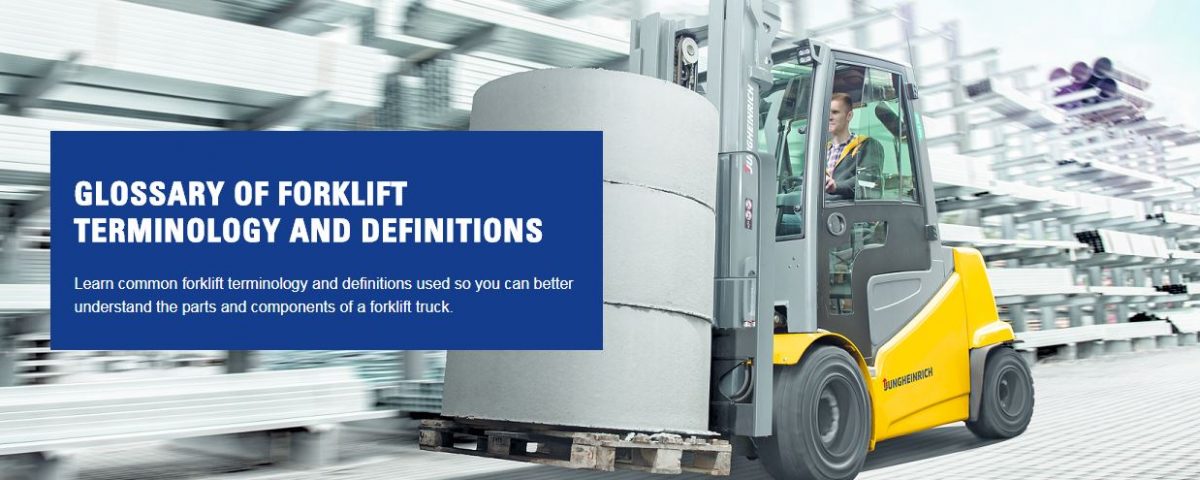Learn common forklift terminology and definitions to enhance your knowledge of forklift parts and components.
Forklift terminology can be confusing at times. If you’re buying a new forklift or looking for a used forklift, it helps to understand the working parts.
Even for seasoned veterans, it’s important to correctly define forklift components for training purposes. To increase your knowledge, provide a reference and support your training efforts, we’ve provided a glossary of common forklift terms.
This forklift glossary is an introductory, but comprehensive, compilation of forklift terminology. If you have questions, please don’t hesitate to contact the G&W sales team.
Lift Cylinder
The forklift lift cylinders are responsible for hydraulically controlling the raising and lowering of the mast.
Load Backrest
The load backrest is a very important part of any forklift. It’s attached to the carriage. When the load is tilted rearward or upward, the load backrest restrains the load. The forklift’s backrest also aids in protecting the mast and cylinder hoses.

Capacity
When buying a forklift or renting a forklift, it’s important to consider the capacity you need for the job. Forklift capacity determines the amount of weight that can be lifted to a specific load height at a specific load center.
Battery Capacity
Battery capacity is a measure of the charge stored by the forklift batteries. It represents the maximum amount of energy (typically measured in amp hours) that can be extracted from the battery during operation.
Battery Compartment
The battery compartment area of the forklift holds the battery or batteries and can vary greatly in size. Battery compartments typically are measured using the length of the compartment multiplied by the width and height (L x W x H). Knowing the dimensions can be an important factor when choosing a forklift suitable for your needs, space and specific application.

Battery Model Identification
It’s important to know the type of battery needed for your specific forklift. Forklift batteries and battery types are easily identified using a battery model identification code, which is expressed as battery style, number of cells, cell Amp/hr, number of plates, cell arrangement, specific features, sequential letters (if needed) and paint codes.
Carriage
Carriage is a frequent term related to forklifts. It refers to the forklift’s support structure, in front of the mast, where the actual forks are mounted.
Cushion Tires
Cushion forklift tires are designed for indoor applications with flat and even surfaces.

Pneumatic Tires
Pneumatic forklift tires are designed for outdoor applications and uneven surfaces. These tires can be filled with a rubber compound (solid pneumatic) or air. Air-filled pneumatic forklift tires are standard on IC trucks, typically. However solid pneumatic tires are sometimes recommended, based on the application. If your work conditions include high amounts of debris and/or you experience frequent tire punctures, solid pneumatic tires may offer a longer tire life. The pneumatic tires on G&W’s rental forklift fleet are all equipped with solid pneumatic tires.

Free Lift
Free lift refers to the amount of vertical movement that a forklift is capable of before additional mast channels are engaged. Essentially, it refers to the forklift’s ability to lift its forks without raising the mast.
Mast
The mast is the vertical structure of a forklift that provides a supporting pathway for the carriage rollers and allows the forklift to raise and lower the forks and material it carries.

Two-Stage Mast
This type of forklift mast has two stages: an outer channel, which is mounted to the lift truck, and an inner channel, which elevates when the cylinders extend.
Truckers’ Mast
This is an exceptionally short, specialized mast, typically used in areas where overhead clearance is restricted. It is used on Class IV and V lift trucks, up to 6,000 capacity.
Max Full Lift Height (MFH)
This term refers to the distance from the floor to the very top of the fork surface, where the mast is fully extended.
Overall Lowered Height (OAL)
This term frequently is used in conjunction with the forklift mast. The overall lowered height is the height at the top of the mast, when the mast is completely lowered. The measurements are taken from the floor to the top of the mast.
Overhead Guard
The overhead guard is the framework fitted to a forklift truck, which provides protection for the forklift operator in case of falling objects.

Tynes
Sometime referred to as the “fork” or the “forks,” tynes are one of the most vital parts of a forklift. These are the arms found on the load carriage. They enter a pallet to lift a load, or the load is placed directly on the forks.

Hook Fork
Some forks will fall under the classification of “hook forks.” These are forks that lock into the forklift carriage and hook over the bars.
Need help choosing the best forklift for your applications?
Contact G&W. Our team is ready to assist you!

